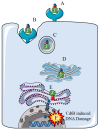Biofilm Producing Salmonella Typhi: Chronic Colonization and Development of Gallbladder Cancer
- PMID: 28858232
- PMCID: PMC5618536
- DOI: 10.3390/ijms18091887
Biofilm Producing Salmonella Typhi: Chronic Colonization and Development of Gallbladder Cancer
Abstract
Salmonella enterica subspecies enterica serovar Typhi is the aetiological agent of typhoid or enteric fever. In a subset of individuals, S. Typhi colonizes the gallbladder causing an asymptomatic chronic infection. Nonetheless, these asymptomatic carriers provide a reservoir for further spreading of the disease. Epidemiological studies performed in regions where S. Typhi is endemic, revealed that the majority of chronically infected carriers also harbour gallstones, which in turn, have been indicated as a primary predisposing factor for the onset of gallbladder cancer (GC). It is now well recognised, that S. Typhi produces a typhoid toxin with a carcinogenic potential, that induces DNA damage and cell cycle alterations in intoxicated cells. In addition, biofilm production by S. Typhi may represent a key factor for the promotion of a persistent infection in the gallbladder, thus sustaining a chronic local inflammatory response and exposing the epithelium to repeated damage caused by carcinogenic toxins. This review aims to highlight the putative connection between the chronic colonization by highly pathogenic strains of S. Typhi capable of combining biofilm and toxin production and the onset of GC. Considering the high risk of GC associated with the asymptomatic carrier status, the rapid identification and profiling of biofilm production by S. Typhi strains would be key for effective therapeutic management and cancer prevention.
Keywords: DNA Damage Response; Salmonella Typhi; biofilm; gallbladder cancer; gallstone; infection; inflammation; skin manifestations; toxin.
Conflict of interest statement
The authors declare no conflict of interest.
Figures



References
Publication types
MeSH terms
LinkOut - more resources
Full Text Sources
Other Literature Sources
Medical
Miscellaneous

